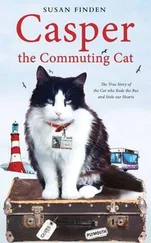Bannister met his wife, Shirley, at a post-regatta party at the CYC. She didn’t care about his modest professional life, and she learned to live with the fact that Bannister spent at least one day of every weekend sailing. When their only child, Stephen, was younger, Bannister took him along. Stephen was born three days apart from fellow crewman John Dean’s son, Nathan, and the two boys spent countless weekends playing on the beach while their fathers raced. Bannister and his son were extremely close; when Stephen was older, the two of them sailed together competitively.
Bannister had been looking forward to the Hobart for months, and he couldn’t wait to get started.
Just before 9:00 A.M. Saturday morning, Geoffrey Bascombe was swimming past the Winston Churchill , which was tied to a dock just outside the CYC clubhouse. Like its owner, the Churchill looked out of place and time.
Bascombe, with an enormous body, bulbous nose, and a two-foot-long beard, presented an altogether different image. He hadn’t weighed himself in more than a decade but knew he was somewhere over three hundred pounds, the reason his friends called him Mega. A former navy sailor who made his living taking care of boats, he had just finished scrubbing the bottoms of four yachts to ensure that they were free of speed-hindering grime. Now that the work was done, he stopped paddling so he could admire the Churchill , which he had seen many times before but always from greater distances.
Mega’s eyes were drawn to an area of the port side near the bow, where he saw a vertical dark line. It was about a foot long and ended just above the waterline. Swimming closer, he was shocked to see what looked like a serious flaw on a yacht that obviously had been meticulously maintained. It looked as if some of the caulking, which is supposed to fill the spaces between planks to make a wooden boat watertight, was missing. The gap was about as wide as the width of a pencil, and when Mega peered inside, he saw what appeared to be a black rubbery compound.
As soon as he emerged from the water, Mega walked toward the Churchill ’s dock, anxious to tell its crew about what he had seen. He knew missing caulking could be the result of shifting planks. With wooden boats, some movement is inevitable, but too much can be catastrophic because it could spring a plank. Mega spoke to two men whom he assumed were members of its crew. “There’s some caulking missing,” he told them. “You should make sure the owner knows about it.”
Richard Winning had been the first member of his crew to arrive at the CYC, but he heard nothing about what Mega Bascombe had seen.
LARRY ELLISON TOOK Sayonara ’s wheel twenty minutes before the start—and disaster struck almost immediately. Four grinders, the muscular crewmen who cranked two bicycle pedal – like contraptions with their arms to provide the force needed to pull in the huge sails, realized it first. When Tony Rae, who was responsible for trimming the mainsail, wanted to let out the sail, he eased the line by letting it slip around the drum of a winch. When he wanted to pull the sail in, he needed help from the grinders, who worked the pedals, two to a station. The men and handles sometimes moved so rapidly that they looked as if they had become a single machine. But now, as they turned the pedals, which turned the winch drum by way of a driveshaft, the grinders heard something they shouldn’t have: a terrible crunching sound. Suddenly the pedals started to turn freely, obviously disengaged. In just twelve knots of wind, the driveshaft, which was made from carbon fiber, had shattered.
Ellison didn’t know what had happened, but he knew he had to continue focusing on steering, particularly when Dickson left his side to investigate the problem. Although Ellison didn’t show any reaction, he was worried. Things are breaking before we even get started , he said to himself. That’s a bad omen.
As soon as Dickson figured out what had happened, he reacted with the kind of blistering fury for which he was famous. “This is ridiculous and inexcusable!” he boomed. “This can’t happen! Our system has failed!” Though things break regularly on most boats, Dickson considered equipment failure on Sayonara unforgivable, except in the most extreme weather conditions. Old or new, everything was supposed to be repeatedly tested and inspected. If something broke in a relatively light wind, someone hadn’t done his job.
When Sayonara had been shipped to Sydney, it was accompanied by two forty-foot-long cargo containers. One was outfitted as an office and a well-equipped workshop, crammed full of tools and spare parts. The other carried the twenty-four-foot chase boat along with other gear. Shouting into a cellular phone, Dickson ordered the driver of the chase boat to rocket back to its on-land base station to fetch a replacement driveshaft. Powered by two ninety-horsepower outboard engines, the chase boat could travel at forty-five knots, but—Dickson belatedly realized—that wouldn’t be fast enough to get to the workshop and back to Sayonara before the ten-minute warning gun at 12:50 P.M., at which point off-yacht support was prohibited. Without the driveshaft, one of Sayonara ’s three main winches would be useless. The crew would be forced to rely on a less powerful and awkwardly located winch in the pit of the cockpit, making it more difficult for Tony Rae to see the sail and control its trim.
Returning to his position near Ellison, Dickson told him, “We’ll have to trim the mainsail from the middle winch. You’re going to have to tack a bit more slowly to give the crew some extra time.”
“That’s going to make it harder to get ahead of the crowd,” said Ellison. “Maybe I should be more aggressive at the start to make sure we get out in front from the beginning.”
Still furious, Dickson nodded.
The start is often the most exciting part of a race—and it can be decisive. Races that are hundreds of miles long are sometimes won by just a few minutes. The first boats to get ahead enjoy uncongested water and air currents that aren’t blocked by other boats. The farther back they are in the fleet, the more yachts are forced to tack back and forth to avoid collisions. Every tack has a cost: it takes a minute or more for the crew to retune the sails and for the yacht to regain optimum speed.
A good start also provides an important emotional boost. Getting the most out of a yacht requires constant attention, an undying eagerness to raise and lower sails and to tweak dozens of lines that change the shape of the sails. The benefits from the constant recalibrating are often so slight as to be virtually imperceptible. When spirits are high, so is the motivation. No one complains about lugging another sail to the deck and folding up the old one. But if nothing seems to work, the mood sinks and no one works as hard. The fun is gone, and so is the point.
The start of the Hobart is particularly challenging. Most races that have a large number of boats have several, staggered starting times, each for a different class of yacht. The Hobart has just one starting time, even though the fleet includes a vast array of shapes and sizes, from maxis like Sayonara and Brindabella , which accelerate so quickly that they seem to have some sort of invisible propulsion system, to tubby thirty-five-foot sloops, which travel about half as fast. The experience level of each helmsman also varies, from America’s Cup veterans to weekend sailors, some of them terrified about setting out on their first Hobart.
The starting line was defined by a boat (from which the starting gun would be fired) at one end and a buoy at the other. Running north to south, the line was about half a mile long and stretched across almost the entire width of the harbor at one of its narrowest points. As Ellison guided Sayonara back and forth behind the line, the wind was blowing at just over ten knots from the northeast. Looking for openings, he felt as if he were driving an Indianapolis 500 car around the track while trying to avoid dozens of careening taxicabs.
Читать дальше












